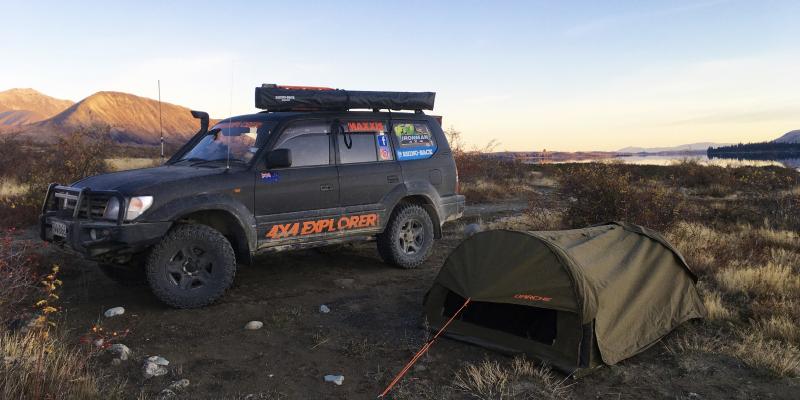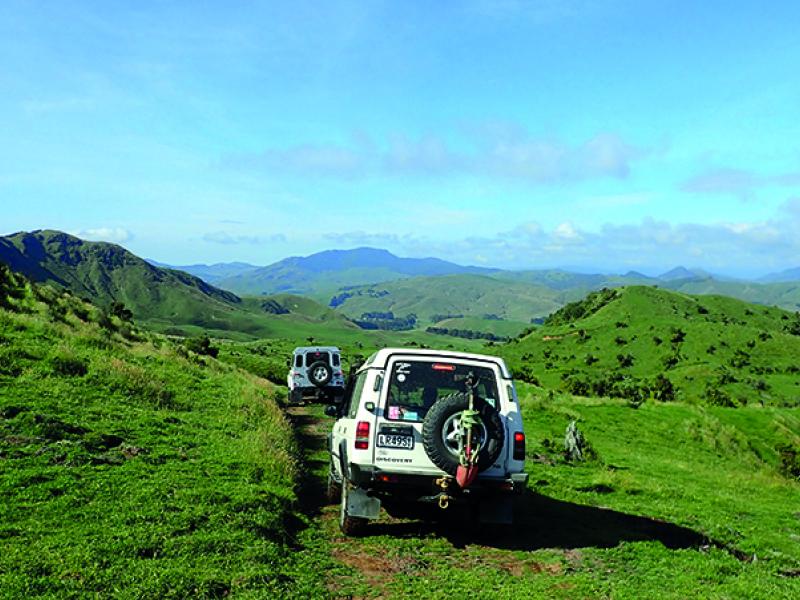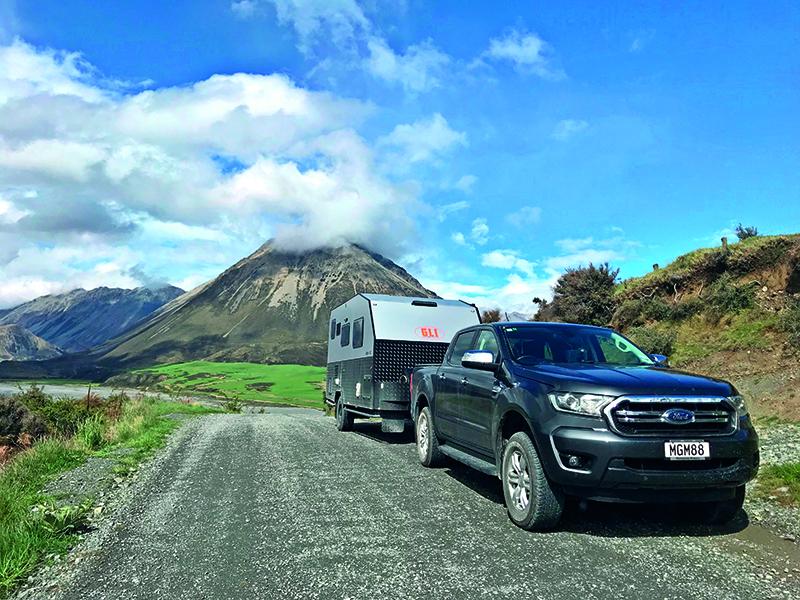A key part of any Overlanding trip is camping out. Here we look at some of the overnight options.
The term overlanding describes self-reliant adventure travel to remote destinations where the journey is the primary goal. Typically using off-road capable vehicles where the principal form of lodging is camping.
Overlanding is about exploration, rather than conquering obstacles. While the roads and tracks we travel might be rough or technically challenging, they are the means to an end and not the goal itself; which is to see and learn about our world, whether it be a weekend trip 100kms from home or a 10,000kms trip across another continent.
Means to an end
The vehicle and equipment can be simple or extravagant as they, too, are simply a means to an end; history, wildlife, scenery and self-sufficiency being the key rewards of overlanding.
It might seem obvious to point out, but the principal form of lodging while overlanding is camping. Being vehicle borne, we have various options available to us and in this article, I will try to set out the pros and cons of these options whilst trying to remain as objective as possible.
The options that will be discussed are Rooftop tents (RTTs), swags, conventional ground tents and various in-truck set-ups.
RoofTop Tents (RTTs)
RTTs are becoming increasingly popular everywhere. Where once, here in NZ, they were the preserve of serious overlanders with highly modified vehicles, they are now commonly seen on rental cars and I mean cars, not trucks!
The history of the RTT is not clear but I’m sure that RTTs first gained popularity on the African continent where sleeping off the ground offers lots of advantages in an environment where the local fauna sees you as their next meal.
RTTs have a solid base platform and a built-in mattress making them very comfortable. As long as you can get your truck reasonably level, you should get a good sleep. If the ground is uneven, a set of Maxtrax can be used to level the vehicle.
Like a tree hut for grown-ups!
They are relatively easy and quick to erect and pack away and you can fold them away with all your bedding inside, so freeing up space in the vehicle.
Many also come with an annex, which creates a separate enclosed room beneath the overhanging sleeping platform. These can be great to provide extra privacy and a sheltered area to change, shower, cook and live in.
Most RTTs are of a reasonable size and so offer you space to move around and a decent degree of privacy if you are camping in close quarters to others. Being away from the ground, also means that they are generally warmer in cold weather.
There’s also something quite fun about being up high... Like a tree hut for grown-ups, and let’s face it, they also look really cool!
There are also hardshell, or clam-type, RTTs, which tend to be easier and quicker to erect, last longer, but are more expensive.
But is an RTT for you?
An RTT is attached to your vehicle and they generally weigh over 60kgs. They are removable, but difficult to do single-handed. If you get away occasionally and your truck is your daily driver, would you be happy fitting and removing one every time you went on a trip or would it become a permanent fixture? Also, once the RTT is erected, the vehicle is immobile. This can be inconvenient if you want to drive off to the beach, collect firewood or have a run to the shops.
You will also end up with a lot of extra weight on the roof, which will have an effect on your vehicle’s centre of gravity. You are also adding extra height, which may become restrictive in close country.
A lot of RTTs are sold online and there are many different models, at different price points and varying levels of quality. I would recommend buying an RTT from a well-known and reputable vehicle outfitter where you can see and touch the product and will get good aftersales service in the case of a failure. Ironman4x4 and Darche sell a range of RTTs and accessories. Local New Zealand company, Feldon Shelter has also been getting good reviews but there are many more.
Great as RTTs are, they are not cheap. As with everything, you tend to get what you pay for. A good quality RTT will cost you in excess of $1500, although there are some available for around the $1000 mark.
If you have a friend who has one, ask if you could borrow it for an overnight trip to see how it works with your set-up.
Swags
Swags are an Australian invention and are also gaining popularity here in NZ, possibly because of the influx of Australian 4WD online retailers such as Adventure Kings.
A swag is the historical Australian name for what is literally a bedroll originally carried by 'swagmen', who were itinerant farm workers who walked from job to job in Australia (and NZ) during the late 1800s to early 1900s.
Today, a swag could be described loosely as a ground-based RTT. They sometimes have a built-in mattress and generally have hooped poles providing a tunnel type shelter and are normally manufactured using polycotton canvas. Many have a side access system with a large opening flap and an insect net inside.
Not a tent
A swag is not a tent and will have restricted headroom. They are really designed as a weatherproof sleeping system.
Bear in mind that, being Australian, they are designed for Australian conditions, which tend to be hot and dry as compared to NZ, which can be cold and wet.
The positive points around swags are that they can be very comfortable, depending on the quality of the mattress – or inflatable air-bed – you end up using. Also, if the ground is particularly wet, muddy or uneven, a Swag can be easily set up in the tub of a ute or on top of a tarp.
They are also very quick to set up and take down and as with an RTT, you can store your bedding inside when packed away. Being free standing you retain the use of your vehicle as well.
Swags come at various price points from around $200 to as much as $1000, and – as far as I see it anyway – the only real drawbacks are the limited headroom, large size when packed and the lack of any covered outdoor space.
In saying that when I’m away solo, I use a Darche swag, which I pitch under my Rhino Rack Batwing awning. Combined with the Darche -12˚C Cold Mountain sleeping bag, I’m guaranteed a great night’s sleep.
Traditional ground tents
The range of ground tents available is huge! They range from small lightweight one-person hiking tents to multi room family holiday tents and can therefore cater to virtually all scenarios.
One of the obvious drawbacks with swags and RTTs is that they are really only good for two people, whereas a large ground tent can accommodate a family. Indeed Aaron Rich and family, 5GoOverland, opted for a Darche AT6 ground tent when crossing Central Asia last year, large enough for all five of them to sleep comfortably out of the elements.
Means to an end
Tents also come in a wide range of price points, and are cheaply available at many of our discount stores here in NZ. This can make a tent a very cost effective entry point into overlanding. As we said in the introduction to this article, equipment can be simple or extravagant and is only a means to an end. If a cheap tent can provide a good night’s sleep and protect you from the elements, why not!
Ultimately, as with all your overlanding equipment, your budget should depend on how much you can afford and how much you will use it.
At 4x4Explorer, when we were away together and prior to acquiring the Darche swag we used a relatively cheap (circa $400) two-person tent that we purchased at Decathlon in France a couple of years ago. It’s self-supporting, so doesn’t need pegging out. This is handy if you want to pitch it on a beach or if the ground is too hard to get pegs in.
It’s called a “Fresh and Black” and has a silver reflective flysheet and black insect netting interior. Primarily designed for use in the South of France, where it gets extremely hot, the advantage is that when it’s closed up, the inside is pitch black! Essential for me to get a good night’s sleep!
The tent itself also takes up very little room in the truck, although, because we travel so much, we do have a 200l weather-proof Rhino Rack cargo bag which contains a double self-inflating mattress, a double duvet and four pillows. This is stored on the roof rack out of the way.
Other advantages of a ground tent, such as ours, are that if we needed to abandon the vehicle and walk out, it is small enough and light enough to take with us and if we are in a campsite, we can still use the truck.
In-Truck set ups
Having said that, we mostly use the ground tent, we also have the possibility of sleeping in the truck.
Both our New Zealand and European 4x4Explorer vehicles have been configured so that we can have a double sleeping platform in the back. In New Zealand, we removed the back seats and created a platform, the size of a double bed, beneath which we store all our equipment. In Europe, we retained the back seats and have a system where we can slide a piece of wood forward, which rests on the reclined rear seats.
We have a set of black hessian curtains that we can use for privacy, though I must say at this point, that my partner, Andrea, really dislikes sleeping in the truck and refers to it as the “Coffin,” maybe on account of the curtains.
Not a huge fan, but…
I’m also not a huge fan. I don’t like the restricted head height and I find it difficult to get in and out of bed. When you reach a certain age and have calls that need to be attended to in the middle of the night, it can be quite an effort, especially if I’m in a sleeping bag.
That said, one of the advantages of sleeping in the truck is that it is very quick. All I need to do is unpack my sleeping bag and it’s ready. I really only sleep in the truck if I arrive somewhere much later than planned or if the ground is just too rocky to erect the tent…which has occurred a few times mainly up High Country Canterbury valleys.
Other advantages are that the truck is totally weatherproof and you benefit from the vehicle’s sound insulation.
Simple & inexpensive
Setting your truck up to enable you to sleep in the back is very simple, inexpensive and can be achieved while retaining the rear seats. I have written an article on how the 4x4Explorer truck is fitted out and there are many articles and videos available on the Internet to show you how.
I have many overlanding friends who sleep in their vehicles and are extremely happy with this option.
I also always keep a sleeping bag in the truck in case I end up spending the night in it for any unforeseen reason or have to walk out. An important part of overlanding is being self-sufficient.
Conclusion
So here we have briefly examined the sleeping options available to us as overlanders. Winch option you choose will be based on how you use your vehicle and how important various factors are to you. These could include speed of set up and stowage, budget, number of people in the party, amount of use, space available, terrain, climate/season and comfort level required.
Whichever system you are using at the moment or are considering in the future, it should be based on what suits YOU best, rather than the latest trend or trends.
Choosing which sleeping system to adopt is one of the most important overlanding decisions that you will make. As we all know, a good night’s sleep after a day behind the wheel is priceless!






